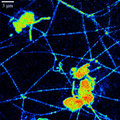Page path:
- Press Office
- Press releases 2013
- 10.09.2013 Viruses and algae in the Sea
10.09.2013 Viruses and algae in the Sea
Viruses and algae in the Sea
Researchers reveal a novel role of viruses in the biogeochemical carbon cycling
Researchers from the Max Planck Institute for Marine Microbiology and their colleagues from the Royal Netherlands Institute for Sea Research uncover how viruses regulate carbon release from the alga Phaeocystis globosa. They published their discovery in the ISME Journal.
Phaeocystis globosa is an alga forming harmful blooms in the coastal waters of the North Sea. The decay of algal biomass at the end of the bloom leads to massive release of organic matter, which in turn stimulates the growth of a variety of heterotrophic gamma- and alpha-proteobacteria.
‘An important source of mortality for these algae are lytic P. globosa viruses. We therefore investigated how algal viral infection and subsequent lysis affects the community structure of the associated bacteria,’ explains Dr. Abdul R. Sheik, the lead author of this study.
In control experiments they showed that the bacterial composition of infected algal cultures differed from non-infected cultures after 5 hours. In order to understand the underlying mechanism Dr. Sheik and colleagues monitored the uptake of the released organic material by the bacterioplankton using isotopically-labeled algal biomass (with isotopes of nitrogen and carbon). Assimilation of the substrate was quantified in single bacterial cells using imaging secondary ion mass spectrometry (nanoSIMS) with a sub-micrometer spatial resolution. ‘Surprisingly, we saw colonization of algal cells and uptake of labeled carbon and nitrogen by Alteromonas cells long before the algal cells lysed’, explains Abdul Sheik. ‘This suggests that infected but still intact algae can already shape the microbial community composition by excretion or leakage of organic matter.’
Researchers reveal a novel role of viruses in the biogeochemical carbon cycling
Researchers from the Max Planck Institute for Marine Microbiology and their colleagues from the Royal Netherlands Institute for Sea Research uncover how viruses regulate carbon release from the alga Phaeocystis globosa. They published their discovery in the ISME Journal.
Phaeocystis globosa is an alga forming harmful blooms in the coastal waters of the North Sea. The decay of algal biomass at the end of the bloom leads to massive release of organic matter, which in turn stimulates the growth of a variety of heterotrophic gamma- and alpha-proteobacteria.
‘An important source of mortality for these algae are lytic P. globosa viruses. We therefore investigated how algal viral infection and subsequent lysis affects the community structure of the associated bacteria,’ explains Dr. Abdul R. Sheik, the lead author of this study.
In control experiments they showed that the bacterial composition of infected algal cultures differed from non-infected cultures after 5 hours. In order to understand the underlying mechanism Dr. Sheik and colleagues monitored the uptake of the released organic material by the bacterioplankton using isotopically-labeled algal biomass (with isotopes of nitrogen and carbon). Assimilation of the substrate was quantified in single bacterial cells using imaging secondary ion mass spectrometry (nanoSIMS) with a sub-micrometer spatial resolution. ‘Surprisingly, we saw colonization of algal cells and uptake of labeled carbon and nitrogen by Alteromonas cells long before the algal cells lysed’, explains Abdul Sheik. ‘This suggests that infected but still intact algae can already shape the microbial community composition by excretion or leakage of organic matter.’
Formation of filamentous star-like structures here visualized with atomic force microscopy (left image) and nanoSIMS (right image) is a unique physiological feature of Phaeocystis globosa.
The bacterial turnover of algal products was so rapid that ca. 40% of the particulate organic carbon was re-mineralized to CO<sub>2</sub> within one week after infection, leaving behind refractive material in the form of cellular star-like structures (see Figure).
These results reveal a new pathway in the transfer of algal biomass to the bacterioplankton and, in a larger picture, new mechanism of retaining carbon in the euphotic zone.
Further Information
Dr. Abdul R. Sheik, +352 46 66 44 5746, [Bitte aktivieren Sie Javascript]
Prof. Dr. Marcel Kuypers, +49 421 2028602, [Bitte aktivieren Sie Javascript]
Press office
Dr. Manfred Schloesser, +49 421 2028704, [Bitte aktivieren Sie Javascript]
Involved institutions
Max Planck Institute for Marine Microbiology, Bremen
Royal Netherlands Institute for Sea Research, Texel
Institute for Biodiversity and Ecosystems Dynamics, Amsterdam
Original article
Responses of the coastal bacterial community to viral infection of the algae Phaeocystis globosa
Abdul R. Sheik, Corina P. D. Brussaard, Gaute Lavik, Phyllis Lam, Niculina Musat, Andreas Krupke, Sten Littmann, Marc Strous and Marcel M. M. Kuypers
doi: 10.1038/ismej.2013.135
These results reveal a new pathway in the transfer of algal biomass to the bacterioplankton and, in a larger picture, new mechanism of retaining carbon in the euphotic zone.
Further Information
Dr. Abdul R. Sheik, +352 46 66 44 5746, [Bitte aktivieren Sie Javascript]
Prof. Dr. Marcel Kuypers, +49 421 2028602, [Bitte aktivieren Sie Javascript]
Press office
Dr. Manfred Schloesser, +49 421 2028704, [Bitte aktivieren Sie Javascript]
Involved institutions
Max Planck Institute for Marine Microbiology, Bremen
Royal Netherlands Institute for Sea Research, Texel
Institute for Biodiversity and Ecosystems Dynamics, Amsterdam
Original article
Responses of the coastal bacterial community to viral infection of the algae Phaeocystis globosa
Abdul R. Sheik, Corina P. D. Brussaard, Gaute Lavik, Phyllis Lam, Niculina Musat, Andreas Krupke, Sten Littmann, Marc Strous and Marcel M. M. Kuypers
doi: 10.1038/ismej.2013.135


